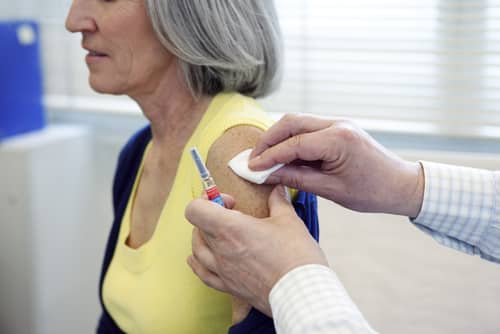
The Centers for Disease Control and Prevention (CDC) estimates that approximately 30 percent of people in the United States will experience shingles during their lifetimes. Age is the most important risk factor for the development of shingles.
Key Facts (from the CDC)
- Shingles and chickenpox are caused by the same virus called varicella zoster virus.
- An estimated 1 million people get shingles each year in the United States.
- Anyone who has had chickenpox can get shingles, and you can get shingles at any age.
- Your risk of getting shingles and having more severe pain increases as you age.
- The shingles vaccine called Shingrix is recommended for people age 50 or older to protect against shingles and the long-term pain that it can cause.
Varicella-zoster virus (VZV) causes two clinically distinct forms of disease: varicella (chickenpox) and herpes zoster (shingles). Your first VZV infection results in the rash we call chickenpox. This rash will resolve and the virus will remain dormant in nerve roots. Re-activation leads to shingles. Shingles is a painful rash that typically affects only one side of the body, forms small fluid-filled sacs in what is called a dermatomal distribution.
Shingles manifests typically as a rash and acute inflammation. The rash changes from red and fluid-filled sacs to crusted sores over about 7 to 10 days. In healthy adults, at this point they are no longer considered infectious. The upper chest/back and lower abdomen/back are the areas most commonly involved. Acute neuritis is the medical term assigned to the painful symptoms most common with shingles. Nearly 75% of patients will experience this type of pain, which can begin before the rash develops. The pain is often described as burning, throbbing, or stabbing where the rash eventually appears.
Complications as a result of shingles is possible and the most common complication is postherpetic neuralgia (PHN). Up to 15% of patients with shingles will develop PHN, which may last beyond four months from the initial onset of the rash. Symptoms include pain, numbness, and pain worsened by movement in the affected dermatome. People older than 60 years account for 50% of these cases.
Similar to other viral or bacterial infections, prevention is key, and vaccination is paramount in preventing both the reactivation of herpes zoster and shingles, as well as, the possible complications associated with the disease.
There are two types of vaccines, recommended based on age. Current evidence suggests Shingrix is the preferred vaccination because of better efficacy and less waning of immunity over time, for people 50-60 years old. People over 60 years old should receive the shingles vaccine Zostavax®, regardless if they have had chickenpox or not. The CDC does NOT recommend Zostavax® in people between the ages of 50 through 59, because the protection from the vaccine may not provide adequate protection later in life, when the risk is greatest. Even if you have had shingles previously, you should still receive the vaccine to prevent future occurrences.
Based on my research, Medicare Part D plans cover the shingles vaccine, but you may have to cover some of the cost or copay. Medicare Part B does not cover the vaccine. Most private health insurance plans cover the vaccine, but this may only apply to those over 60 years old. For clarification, please contact your insurance provider. Walgreens and CVS in Peoria, do carry both vaccines. The pharmacist can give the injection, but may require a prescription from your primary care physician. The cost without insurance may be around $250 to $350. Other pharmacies may carry the vaccine – call your local pharmacy to confirm.
Prevention Tips (from the CDC)
- People who have a weakened immune system should talk to their healthcare provider to see if it is safe for them to get the shingles vaccine.
- People who have previously had shingles or Zostavax® should still get Shingrix to help prevent future occurrences of the disease.
- The shingles vaccines are available in pharmacies and doctors’ offices. Talk with your primary healthcare provider if you have questions about the shingles vaccines.
- If you have shingles, don’t touch the rash, keep it covered and stay away from pregnant women who aren’t protected against chickenpox, premature infants, and people with weakened immune systems until the rash crusts over.
For more information: https://www.cdc.gov/shingles/
Kaleb Jacobs, DO
